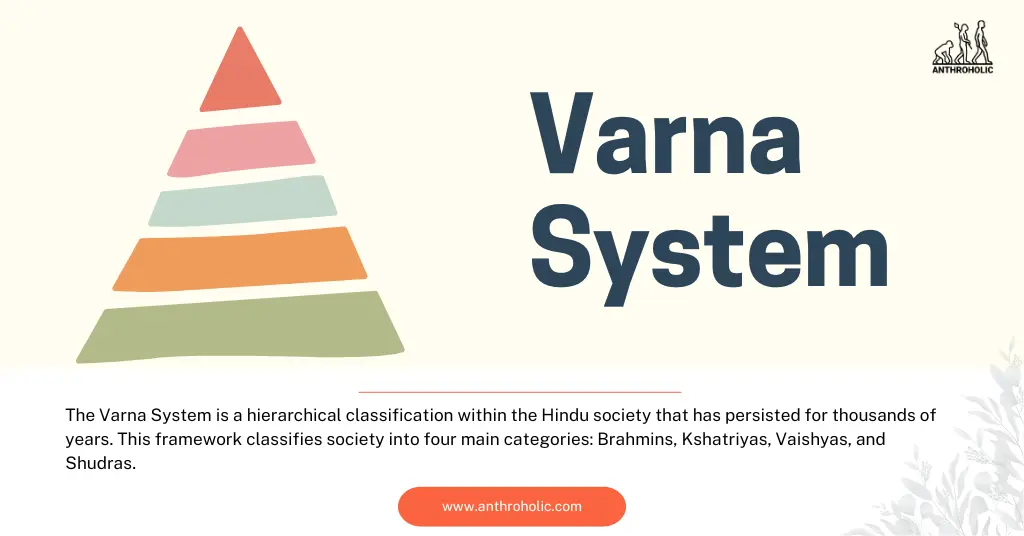AI Answer Evaluation Platform Live Now. Try Free Answer Evaluation Now
Varna System
The Varna System is a hierarchical classification within the Hindu society that has persisted for thousands of years. This framework classifies society into four main categories: Brahmins, Kshatriyas, Vaishyas, and Shudras.

Historical Background
Origins
The Varna System finds its roots in the ancient Indian scriptures known as the Vedas, which were composed around 1500 BCE [1]. This categorization aimed at defining social roles based on individuals’ attributes and occupation.
- Brahmins: Priests and scholars
- Kshatriyas: Warriors and rulers
- Vaishyas: Merchants and farmers
- Shudras: Laborers and service providers
Evolution
The system’s transformation over time led to complex social stratification, often conflated with the Jati or caste system. The connection between the two, however, is debatable and multifaceted [2].
Table 1: Differences between Varna and Jati System
| Varna System | Jati (Caste) System |
|---|---|
| Based on inherent qualities and duties | Based on birth and occupation |
| More philosophical in nature | More rigid and hierarchical |
Sociocultural Aspects
Function within Society
The Varna System served as a social code to maintain order by allocating duties and responsibilities. While it was theoretically flexible, social mobility became restricted over time [3].
Impact on Modern Society
Despite changes in legislation and social reform movements, remnants of the Varna system linger in various aspects of contemporary Indian society, including marriage, education, and occupation [4].
In-depth Analysis
Philosophical Underpinnings
The Varna System is deeply rooted in the ancient Indian philosophy of Dharma, which emphasizes duty and moral order. According to the Rigveda, the universe was created from the cosmic being Purusha, with each Varna corresponding to different parts of his body.
Social Dynamics and Change
Mobility within the Varna System
In its early forms, the Varna System allowed mobility based on merit and actions, but this flexibility diminished over time, solidifying into a more rigid structure.
Interaction with Colonialism
British colonial rule intensified the rigidity, employing the caste system for administrative purposes and misunderstanding the nuanced differences between Varna and caste.
Gender Perspective
The Varna System’s influence on gender roles and rights has been substantial. Women’s status within the Varna hierarchy often depended on their family’s position, leading to a complex relationship between Varna and gender equality.
Contemporary Relevance
Influence on Politics
Political parties in India have sometimes aligned with or opposed the Varna system to gain support or advocate for reform. The political discourse continues to be influenced by Varna identities.
Impact on Economic Structure
The Varna system continues to influence the socio-economic landscape of India. Studies show a correlation between Varna status and access to education, employment, and resources.
Legal Perspectives
Indian law has attempted to address discrimination arising from the Varna system through affirmative action policies and legal protections. These measures aim at promoting social justice and reducing inequalities.
Future Prospects and Challenges
The future of the Varna System within Indian society lies at a complex intersection of tradition, modernity, globalization, and social reform. The continuing debates and dialogues reflect a dynamic interplay of forces that challenge and reshape the understanding of social hierarchy.
Conclusion
The Varna System remains a profound and intricate aspect of Indian civilization. Its layers of complexity, historical evolution, and contemporary relevance provide fertile ground for continued exploration and dialogue. The system’s multifaceted impact on social, political, economic, and legal spheres offers a comprehensive view of the intricate relationships that shape human societies.
References
[1] Basham, A. (1959). The Wonder That Was India. Sidgwick & Jackson. https://ia800501.us.archive.org/8/items/TheWonderThatWasIndiaByALBasham/The%20Wonder%20that%20was%20India%20by%20A%20L%20Basham_text.pdf
[2] Dirks, N.B. (2001). Castes of Mind: Colonialism and the Making of Modern India. Princeton University Press.
[3] Béteille, A. (1996). Caste, Class, and Power. Oxford University Press.
[4] Srinivas, M.N. (1996). Caste: Its Twentieth Century Avatar. Viking.
[5] Ambedkar, B.R. (1936). Annihilation of Caste. Thacker & Co.




